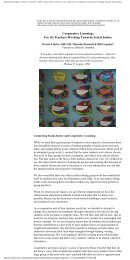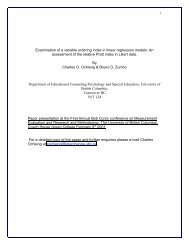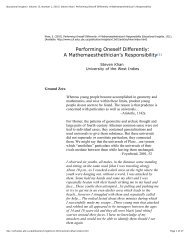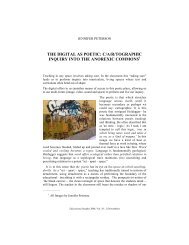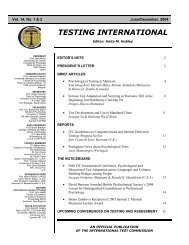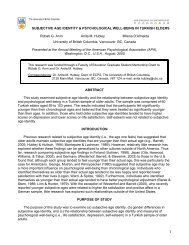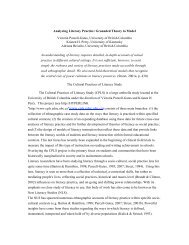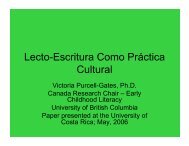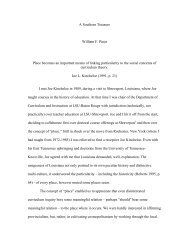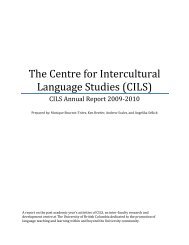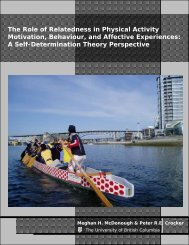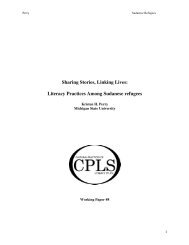The evolution of professionalism - Centre for Policy Studies in ...
The evolution of professionalism - Centre for Policy Studies in ...
The evolution of professionalism - Centre for Policy Studies in ...
You also want an ePaper? Increase the reach of your titles
YUMPU automatically turns print PDFs into web optimized ePapers that Google loves.
agreed to pay the teachers’ unfunded pension liability <strong>for</strong> one year. <strong>The</strong> ATA<br />
stressed that the agreement was not comprehensive but was a good start, while the<br />
ASBA saw it as a means to a smoother arbitration process.<br />
<strong>The</strong> ATA has a long history <strong>of</strong> advocat<strong>in</strong>g <strong>for</strong> education <strong>in</strong> Alberta and <strong>of</strong> work<strong>in</strong>g<br />
to improve the teach<strong>in</strong>g pr<strong>of</strong>ession. It regularly publishes position papers to <strong>in</strong>crease<br />
public awareness <strong>of</strong> issues <strong>in</strong> education (e.g., Fall<strong>in</strong>g Through the Cracks, 2002).<br />
While the good faith agreement enabled teachers to resume voluntary services, a<br />
necessary dialogue has cont<strong>in</strong>ued with the ASBA and the M<strong>in</strong>istry.<br />
Bill 205, the School Trustee Statutes Amendment Act (2002) was also<br />
contentious. Positioned as a clarifi cation <strong>of</strong> possible “pecuniary confl icts <strong>of</strong> <strong>in</strong>terest”,<br />
the Bill prohibits teachers and other employees <strong>of</strong> a school district from serv<strong>in</strong>g as<br />
school trustees; prior to this, teachers could serve as trustees <strong>in</strong> school jurisdictions<br />
that were not their employer. Critics have labelled it as a means to exclude teachers<br />
“from participat<strong>in</strong>g <strong>in</strong> one level <strong>of</strong> our democratic process”, argu<strong>in</strong>g that it restricts<br />
“representation <strong>of</strong> a certa<strong>in</strong> segment <strong>of</strong> society” (Hansard, May 6, 2002).<br />
<strong>The</strong> Alberta Learn<strong>in</strong>g Bus<strong>in</strong>ess Plan <strong>for</strong> 2002-05 stresses a system that is<br />
“responsible, fl exible, accessible, and af<strong>for</strong>dable” (2002, p. 2). One <strong>of</strong> the priorities<br />
<strong>of</strong> Alberta Learn<strong>in</strong>g <strong>for</strong> 2002-03 was the Commission on Education, which was<br />
established, and began to solicit submissions and conduct consultations, <strong>in</strong> June<br />
2002. <strong>The</strong> commission emerged from the Alberta Future Summit (2002), where<br />
delegates recommended a comprehensive review <strong>of</strong> the education (learn<strong>in</strong>g)<br />
system. <strong>The</strong> government’s commitment to exam<strong>in</strong>e the system was referenced <strong>in</strong><br />
the Education Services Settlement Act (2002). A progress report was produced<br />
<strong>in</strong> January 2003 and the fi nal report, Every Child Learns, Every Child Succeeds:<br />
Report and Recommendations, was released <strong>in</strong> October 2003.<br />
<strong>The</strong> commission report suggested further accountability measures:<br />
• Prov<strong>in</strong>cial achievement tests and diploma exams will be ma<strong>in</strong>ta<strong>in</strong>ed and<br />
improved. Ongo<strong>in</strong>g classroom assessment will be supported;<br />
• <strong>The</strong>re will be a means <strong>for</strong> prov<strong>in</strong>ce-wide <strong>in</strong><strong>for</strong>mation and accountability<br />
through ongo<strong>in</strong>g <strong>in</strong><strong>for</strong>mation about the outcomes achieved by students;<br />
• Report<strong>in</strong>g requirements are <strong>in</strong>creased <strong>in</strong> the school, school jurisdictions,<br />
and by the prov<strong>in</strong>ce; and,<br />
• <strong>The</strong> creation <strong>of</strong> a new Council <strong>of</strong> Education Executives to provide<br />
certifi cation, ongo<strong>in</strong>g support and pr<strong>of</strong>essional development <strong>for</strong> pr<strong>in</strong>cipals<br />
and assistant pr<strong>in</strong>cipals, effectively remov<strong>in</strong>g same from the ATA (Report<br />
and Recommendations, Alberta’s Commission on Learn<strong>in</strong>g, 2003).<br />
<strong>The</strong> commission report recommended numerous dramatic re<strong>for</strong>ms affect<strong>in</strong>g<br />
teachers and school leaders:<br />
• Establish and implement prov<strong>in</strong>ce-wide guidel<strong>in</strong>es <strong>for</strong> class sizes across<br />
school jurisdictions;<br />
• Review and improve current pre-service programs <strong>for</strong> teachers;<br />
• Establish a permanent mechanism <strong>for</strong> ensur<strong>in</strong>g closer l<strong>in</strong>ks among faculties<br />
<strong>of</strong> education, super<strong>in</strong>tendents, teachers and Alberta Learn<strong>in</strong>g;<br />
• Require schools jurisdictions to adapt the fi rst-year experience and provide<br />
effective coach<strong>in</strong>g <strong>for</strong> beg<strong>in</strong>n<strong>in</strong>g teachers;<br />
Chapter 2: Alberta 41




